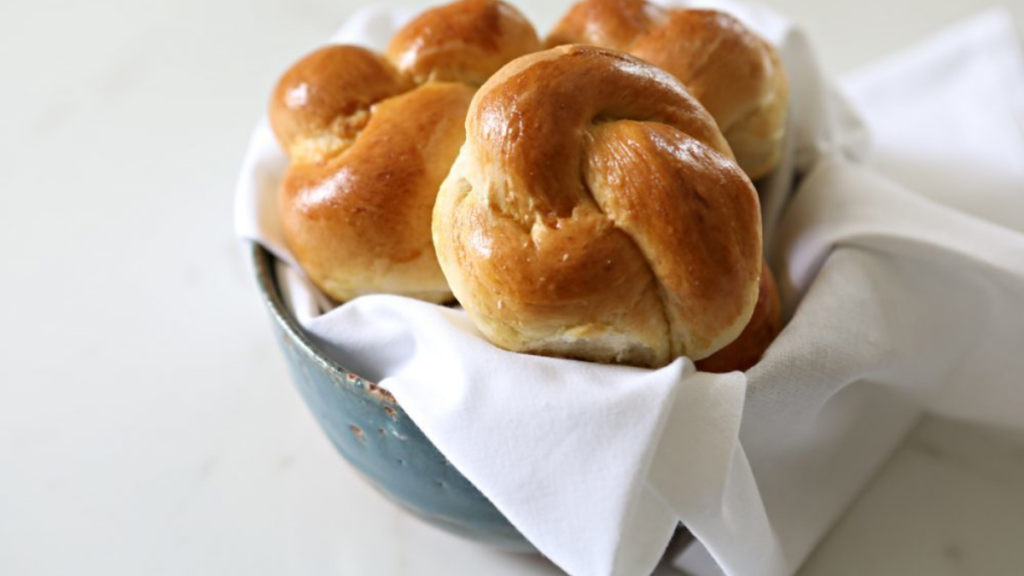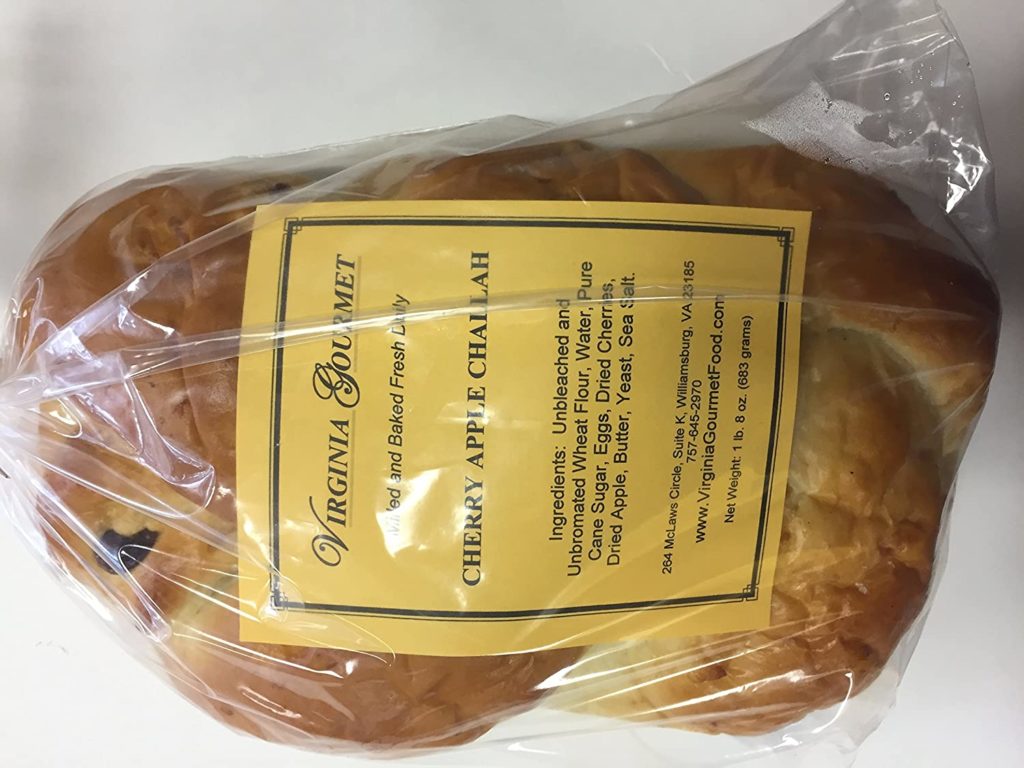Challah bread (also spelled hallah and pronounced hall-ah) is a soft, fluffy Jewish staple frequently consumed during special meals, from indulgent Sunday French toast brunches with friends to traditional Shabbat Friday night family dinners. Challah is a sweeter Kosher bread usually braided with egg-washed, shiny crusts and often contains no dairy or meat. Because most American and European bread contain butter or milk, lactose intolerant people and those watching their dairy intake find challah appealing.
Eggs, delicate white, high-gluten flour, water, yeast, sugar, and salt are all used in a typical challah recipe. However, there are many recipe variations; for example, some challah recipes do not use eggs. Before baking, it’s common to brush it with an egg wash and sprinkle it with poppy seeds, rolled oats, or sesame seeds. You can add cinnamon, chocolate chips, Nutella, or raisins to the mix to add flavor.
What is Challah Bread?
Challah is a braided bread loaf. Eggs, water, flour, yeast, and salt are used to make the simple dough. Because so many eggs are used, the bread is typically pale yellow and has a rich flavor. Some challah recipes call for raisins, honey, or seeds to be added. It all depends on the occasion and your tastes. The mitzvah (a blessing or good deed) of separating a portion of the dough before braiding contributes to the Kohen is known as Challah (priest). The Parashat Challah is the name for this commandment.
Challah Nutrition Facts
Carbs
Challah has 18 grams of total carbs, 7% of the daily recommended value, and wheat flour and honey provide the carbohydrates. Overall, Challah does not contain nearly as many carbohydrates as other European-style sweet, egg-based pieces of bread. Because Challah is sweetened with honey, egg, and a pinch of sugar, it has a semi-confectionery flavour without the cups of white and brown sugar in the dough.
Fats
The total lipid fats in a serving of challah bread are two grams or three percent of your recommended daily value. The total saturated fat amount in a serving is 1 gram, and you will not find any unhealthy trans fats.
Protein
Challah bread only contains 3 grams of protein.
Vitamins and Minerals
Challah bread offers trace amounts of the following:
- Niacin helps to turn the food you eat into energy
- Iron is a deficiency that results in anemia
- Thiamin, which is essential for metabolism
- Riboflavin, which is essential for red blood cell production and is essential for growth
- Folic acid helps the body to make healthy new cells
What are the Health Benefits of Challah Bread?
Here are the health benefits of eating challah bread:
- Reduces cardiovascular events derived from extra virgin olive oil Researchers studied 7,216 men and women at high cardiovascular risk, aged 55 to 80 years, in a large May 2014 study published in BMC Medicine and discovered that each 10-gram increase in EVOO consumption daily was associated with a 10% reduction in the risk of cardiovascular events.
- Offers anti-aging properties derived from honey. According to a study published in April 2017 by Pharmacognosy Research, this natural sweetener helps control oxidative stress, which can cause premature aging.
Allergies
Anyone with allergies to the following should avoid consuming challah bread:
- Eggs. According to a study in the Pediatrics Clinic of North America, an egg allergy is the second most common food allergy in infants and young children.
- Wheat. Luckily for anyone with a wheat allergy, wheat is one of eight allergens with labeling requirements under the Food Allergen Labeling and Consumer Protection Act (FALCPA) of 2004, according to the American College of Allergy, Asthma & Immunology. Under this law, U.S. manufacturers of food products that contain wheat, such as prepackaged challah bread, must include “wheat” on the ingredient label — keeping you safe from any ingredient surprises.
- Yeast. According to the Canadian Society of Intestinal Research, allergists would advocate avoiding wheat flour if you have symptoms of a yeast allergy, which includes difficulty breathing, hives, cardiac issues, and angioedema (swelling beneath the skin).
What are the Varieties of Challah Bread?
There are dozens of prepackaged challah bread varieties available and recipes ranging from savory to spicy to sweet. The following are examples of popular types:
- Classic Challah. The simple dough is made with water, eggs, oil, water, enriched flour, yeast, and salt. The color of the bread is usually a pale yellow for its egg content in the dough and the egg wash over the crust. Classic Challah is also kosher (as its traditionally known for being a Jewish food eaten during Shabbat, Rosh Hashanah, and Purim).
- Whole wheat challah. Using whole wheat makes this bread a little healthier than the classic version.
- No-knead Challah. If you want to try making homemade Challah, this version is more accessible than the classic version, especially for amateur bakers without a bread-baking background.
- Pumpkin challah. You can experiment with more savory flavors and create challah varieties for particular seasons, such as pumpkin for Thanksgiving and cinnamon for the holidays.
- You can add Indian spices for a unique flavor profile and fusion of cultures popular in modern-day cuisine for those with savory palettes.
When it’s Best?
- For prepackaged challah bread, you should read the label of its sell-by date, as bread can start to mold within seven days.
- For those who want to freeze Challah, you can keep the bread in an airtight freezer bag for three months. For help not forgetting the exact date you freeze it, write down the month and day on the bag.
- To defrost, take the bread out of the freezer approximately five hours before you want to serve it, and the Challah should reach room temperature by then.
Challah Bread – Cherry Apple Challah
Features:
- All Natural- No Additives, No Preservatives, No Sugar Substitutes
- Delicious Tasty Moist Authentic Challah Bread
- 2- PACK 7-day shelf life, 14 days refrigerate, & freeze for up to 6 months
- Great Sandwich Bread, Snack with Honey & French Toast
- It May take up to 3 weeks for delivery to ensure product integrity and freshness
What is so Special About Challah Bread?
Challah is traditionally defined as any bread made for Jewish ritual use. Challah included everything from rich, layered loaves of bread baked overnight in Yemen to pita pockets in Syria and lepeshka flatbreads in the Caucasus during Jewish life’s first few thousand years. Later, as Challah traveled with the Jews, it was adorned with poppy seeds in Hungary, soaked in orange blossom water in Libya, and mixed with pumpkin in Spain.
Challah evolved into the fluffy, egg-enriched, sugar-laced, six-stranded braid that we recognize in the Ashkenazi world — that of the Jews who made their way to Central and Eastern Europe over time. Challah evolved in different directions among the Sephardic Jews of North Africa and the Middle East. They trace their ancestry and traditions back to Spain before the Inquisition and often to the Roman Empire.
Spices, honey, and oils from olives, nuts, and seeds were plentiful, while eggs and sugar were scarce. As a result, unique regional challahs arose: doughs liberally sprinkled with sesame or poppy seeds, fragrant with aniseed, cardamom, or coriander, and enriched with almond or olive oil. Spices like saffron and za’atar, orange flower and rose water, and candied fruit and nuts, were all used in these elaborate challahs. These loaves are often studded with whole nuts, streaked with sweet fillings, or bumpy with whole spices, unlike smooth Ashkenazi challahs.
Conclusion
Similar to brioche, Challah is a yeast bread enriched with eggs. The most significant difference between Challah and brioche bread dough is that brioche contains a lot of butter, whereas Challah contains oil. The flavor is reminiscent of brioche bread. Because of the egg yolks, the texture is rich and spongy, with a hint of tang from the honey. To put it that way, it’s a little soft, sweet, and a whole lot delicious. Challah bread is delicious, nutritious, and simple to make.
Challah has 13 grams of total carbs, 4% of the daily recommended value. Wheat flour and honey provide the carbohydrates. Overall, Challah does not contain nearly as many carbohydrates as other European-style sweet, egg-based pieces of bread.




